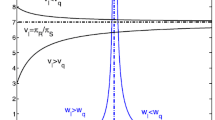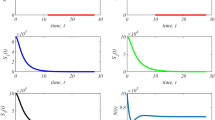Abstract
A class of mathematical models for cancer chemotherapy which have been described in the literature take the form of an optimal control problem over a finite horizon with control constraints and dynamics given by a bilinear system. In this paper, we analyze a two-dimensional model in which the cell cycle is broken into two compartments. The cytostatic agent used as control to kill the cancer cells is active only in the second compartment where cell division occurs and the cumulative effect of the drug is used to model the negative effect of the treatment on healthy cells. It is shown that singular controls are not optimal for this model and the optimality properties of bang-bang controls are established. Specifically, transversality conditions at the switching surfaces are derived. In a nondegenerate setting, these conditions guarantee the local optimality of the flow if satisfied, while trajectories will be no longer optimal if they are violated.
Similar content being viewed by others
References
EISEN, M., Mathematical Models in Cell Biology and Cancer Chemotherapy, Lecture Notes in Biomathematics, Springer Verlag, Berlin, Germany, Vol. 30, 1979.
KIM, M., WOO, K. B., and PERRY, S., Quantitative Approach to the Design of Antitumor Drug Dosage Schedule via Cell Cycle Kinetics and Systems Theory, Annals of Biomedical Engineering, Vol. 5, pp. 12–33, 1977.
MARTIN, R. B., Optimal Control Drug Scheduling of Cancer Chemotherapy, Automatica, Vol. 28, pp. 1113–1123, 1992.
SWAN, G. W., General Applications of Optimal Control Theory in Cancer Chemotherapy, IMA Journal of Mathematics and Applied Medical Biology, Vol. 5, pp. 303–316, 1988.
SWAN, G.W., Role of Optimal Control in Cancer Chemotherapy, Mathematical Biosciences, Vol. 101, pp. 237–284, 1990.
TANNOCK, I., Cell Kinetics and Chemotherapy: A Critical Review, Cancer Treatment Reports, Vol. 62, pp. 1117–1133, 1978.
WHELDON, T. E., Mathematical Models in Cancer Research, Bristol Medical Science Series, Hilger, 1988.
KIRSCHNER, D., LENHART, S., and SERBIN, S., Optimal Control of Chemotherapy of HIV, Journal of Mathematical Biology, Vol. 35, pp. 775–792, 1997.
FISTER, K. R., and PANETTA, J. C., Optimal Control Applied to Cell-Cycle Specific Cancer Chemotherapy, SIAM Journal on Applied Mathematics, Vol. 60, pp. 1059–1072, 2000.
KIMMEL, M., and SWIERNIAK, A., An Optimal Control Problem Related to Leukemia Chemotherapy, Scientific Bulletin of the Silesian Technical University, Vol. 65, pp. 120–130, 1983.
SWIERNIAK, A., POLANSKI, A., and KIMMEL, M., Optimal Control Problems Arising in Cell-Cycle Specific Cancer Chemotherapy, Cell Proliferation, Vol. 29, pp. 117–139, 1996.
SWIERNIAK, A., and DUDA, Z., Bilinear Models of Cancer Chemotherapy: Singularity of Optimal Solutions, Mathematical Population Dynamics, Vol. 2, pp. 347–358, 1995.
SWIERNIAK, A., POLANSKI, A., and DUDA, Z., Strange Phenomena in Simulation of Optimal Control Problems Arising in Cancer Chemotherapy, Proceedings of the 8th Prague Symposium on Computer Simulation in Biology, Ecology, and Medicine, pp. 58–62, 1992.
SWIERNIAK, A., Cell Cycle as an Object of Control, Journal of Biological Systems, Vol. 3, pp. 41–54, 1995.
ROXIN, E. O., Control Theory and Its Applications, Gordon and Breach Science Publishers, London, England, 1997.
LEDZEWICZ, U., and SCHÄTTLER, H., Optimal Controls for a 3-Compartment Model of Cancer Chemotherapy, Journal of Biological Systems (to appear).
PONTRYAGIN, L. S., BOLTYANSKII, V. G., GAMKRELIDZE, R. V., and MISHCHENKO, E. F., The Mathematical Theory of Optimal Processes, MacMillan, New York, NY, 1964.
DUDA, Z., A Gradient Method for Application of Chemotherapy Models, Journal of Biological Systems, Vol. 3, pp. 3–11, 1995.
DUDA, Z., Numerical Solutions to Bilinear Models Arising in Cancer Chemotherapy, Nonlinear World, Vol. 4, pp. 53–72, 1997.
LEDZEWICZ, U., and SCHÄTTLER, H., Optimal Control for a Mathematical Model of Cancer Chemotherapy, Proceedings of the IASTED International Conference on Control and Applications, Edited by M. H. Hamza, IASTED/Acta Press, Anaheim, California, pp. 8–14, 2000.
LEDZEWICZ, U., and SCHÄTTLER, H., On a Synthesis of Controls for a Mathematical Model of Cancer Chemotherapy, Proceedings of the 39th IEEE Conference on Decision and Control, Sydney, Australia, pp. 4845–4850, 2000.
NOBLE, J., and SCHÄTTLER, H., Sufficient Conditions for Relative Minima of Broken Extremals in Optimal Control Theory, Journal of Mathematical Analysis and Applications, 2002 (to appear).
SUSSMANN, H., Envelopes, High-Order Optimality Conditions, and Lie Brackets, Proceedings of the 28th IEEE Conference on Decision and Control, Tampa, Florida, pp. 1107–1112, 1989.
NOWAKOWSKI, A., The Proof That a Control with One Switch Is Optimal in a Simple Control Problem Arising in Chemotherapy, Proceedings of the Conference on Medical and Biological Applications of Mathematics, Warsaw, Poland, 1996.
NOWAKOWSKI, A., Field Theories in the Modern Calculus of Variations, Transactions of the American Mathematical Society, Vol. 309, pp. 725–752, 1988.
MOHLER, R. R., Bilinear Control Systems, Academic Press, New York, NY, 1973.
KRENER, A., The High-Order Maximal Principle and Its Application to Singular Controls, SIAM Journal on Control and Optimization, Vol. 15, pp. 256–293, 1977.
KIEFER, M., and SCHÄTTLER, H., Parametrized Families of Extremals and Singularities in Solutions to the Hamilton-Jacobi-Bellman Equation, SIAM Journal on Control and Optimization, Vol. 37, pp. 1346–1371, 1999.
BRYSON, A. E., and HO, Y. C., Applied Optimal Control, Hemisphere Publishing, Washington, DC, 1975.
KAILATH, T., Linear Systems, Prentice Hall, Englewood Cliffs, New Jersey, 1980.
NOBLE, J., Parametrized Families of Broken Extremals and Sufficient Conditions for Relative Extrema, DSc Thesis, Department of Systems Science and Mathematics, Washington University, St. Louis, Missouri, 1999.
Author information
Authors and Affiliations
Rights and permissions
About this article
Cite this article
Ledzewicz, U., Schättler, H. Optimal Bang-Bang Controls for a Two-Compartment Model in Cancer Chemotherapy. Journal of Optimization Theory and Applications 114, 609–637 (2002). https://doi.org/10.1023/A:1016027113579
Issue Date:
DOI: https://doi.org/10.1023/A:1016027113579




